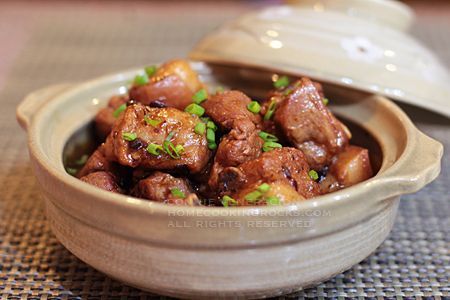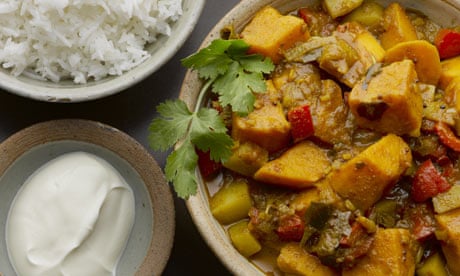Vindaloo - sweet and sour, not hot
- rosemary
- Jun 14, 2022
- 7 min read
"A Goan vindaloo is not the mind-blowingly spicy curry as it has come to be known in the UK, but a rich, hot, slightly sweet and sour gravy,"
Cyrus Todiwala

I'm returning to my Anglo-Indian cuisine occasional series. This time with vindaloo which is not even based on an Indian dish, but a Portuguese one, so you could say that it's actually Anglo-Portuguese. But then again it's really Portuguese/Indian/English - in that order. And as I discovered it's a dish that has travelled the world and been adapted to local tastes and ingredients along the way.
Where to begin? Perhaps with the original dish Carne vinha d'alhos - meat with wine and garlic, which doesn't even come from mainland Portugal but from the islands of Madeira and the Azores. So the wine is generally thought to be Madeira although often Port is substituted. Both of these are fortified, so I don't know whether the 'authentic' original dish would use these. Wine, not vinegar though.
I tried to find an authentic recipe but honestly I'm not sure about what I found. The recipe title does not mention vinegar, which is crucial to a vindaloo, but there are reasons for that that I shall come to. The first picture below of a Carne vinha d'alhos is from a Portuguese lady's blog - Tia Maria's Blog, and so you would have to think that it was how the Portuguese make it. The second Carne vinha d'alhos is from an American - Just cook with Michael, but he claims it is authentic. I do have a couple of Portuguese cookbooks, but neither of them mention it. I can say with reasonable certainty that it emanates from Madeira, that it is a traditional Christmas dish and that red wine is involved - but hardly any chilli - just a touch - but the main flavours seem to be allspice and bay leaves - and the garlic of course. However the recipes I found did have vinegar in them, and perhaps it was in the original because it's a way of preserving the meat.
The Portuguese, of course, were great seafarers and colonists too and so this particular dish has been spread around the world to places such as Brazil, Angola, Mozambique and Macau. I could not find specific recipes for these recipes but I did find references to dishes called Vina Dosh, and Vinyoo Dalyge. Christmas and similar celebrations seemed to be a common factor as did the vinegar, chillies too but in varying degrees of heat.

I also found a Hawaiian recipe - this Crispy vinha d'alhos from Ono Hawaiian Recipes. Hawaii? Well in 1878 Portuguese labourers were imported to Hawaii from Madeira to labour in the sugar cane fields, and from there came this crispy version, although there are also stewier versions too. For Christmas, there as well.
But back to India and vindaloo - vindaloo, the name, of course, being a perversion of the original name - Carne vinha d'alhos. The Portuguese settled in Goa on India's East Coast and more or less converted the inhabitants to Catholicism. When my father was working on the P&O's cargo ships the cooks and the stewards on the boat were all Goanese with names like Jesus and Nazareth and Bethlehem. So it is probably true that the Goanese have spread themselves around the world. The Portuguese came to Goa with Vasco da Gama in 1498 but they settled and ruled there from 1505-1961. The Muslim and Hindu population, became Christian, and so when the British became the major colonial power in India they employed many Goanese cooks because they would cook pork and beef and the Hindu and Muslim cooks would not. I'm guessing the P&O followed suit - hence the Goanese on my father's ships.
The Portuguese brought with them their Carne vinha d'alhos, wine, vinegar and chillies. Chillies had previously been unknown in India. Hard to imagine Indian cuisine without them these days is it not - like the Italians and tomatoes and the British and potatoes? It is said that when they came to make their beloved meat dish they found that their wine had turned sour and turned to vinegar, and so they used this instead of the wine. Which added to the savour of the dish. They also did not have the same herbs and so local ones were substituted. Peppercorns had been the Indians' hot spice and other local spices such as cinnamon and cardamom were added. The dish was popular but the Indians had no vinegar, and so:
“Some ingenious Franciscan priests are said to have solved the problem by manufacturing vinegar from coconut toddy, the alcoholic drink fermented from the sap of the palm tree. This, combined with tamarind pulp and plenty of garlic, satisfied the Portuguese cooks,” Lizzie Collingham
And indeed The Goans still use a coconut vinegar. The photograph at the top of the page is of a genuine Goan restaurant version - the restaurant being called Hospedaria Venite in the town of Panaji in Goa. It looks delicious, but alas there is no recipe.
The vinegar, as I mentioned before, is a preservative and I saw several articles that said that, as it is a festive dish in India it is often made in vast quantities days before the event, reheated each day to kill off the bacteria, and finally served. I also saw that the Portuguese sailors covered it in oil and took it with them on their travels. All sounds a bit dodgy but it is certainly one of those dishes that tastes better the day after it is made. Put it in the fridge overnight though.
As to marinading the meat. Well this varies from a few hours to a few days. Felicity Cloake maintains that you shouldn't marinade it for too long because the vinegar, being acidic, will sort of cook the meat and make it tough. Christine Manfield also only marinates for a short period, so I think I would go for that. Sorry - her recipe (for pork) is not online. Now don't they look so different from each other?

The Portuguese made their version with pork but the British it seemed, preferred duck and beef. Madhur Jaffrey also prefers duck and published a version of her Duck vindaloo in her book The Ultimate Curry Bible.
And what about the chilli? Well since the colonial days and from the 1970s on when the Indians and Pakistanis began to emigrate to Britain in huge numbers, and the love affair of the British and Indian food began, Vindaloo has come to mean hot, hot, hot. It's almost a competitive thing to see who can make - and eat the hottest vindaloo. It's a laddish thing and led to the official anthem for the English football fans for the 1998 FIFA World Cup, being a song about vindaloo - the chorus being : “Vindaloo, Vindaloo, Vindaloo. We’re gonna score one more than you" which:
“persuaded, among others, a lot of xenophobic, racist Little England football supporters to celebrate an item of Indian cuisine as a quintessential expression of Englishness. This is despite Goa having been a former Portuguese colony and one of the few parts of India that never saw British rule." The Observer
I just love that. It's sort of the worst and the best of the British all rolled into one.
Back to the chilli. The more 'authentic' recipes use very little, or use Kashmiri chilli powder which is milder. According to the Recipe Tin Eats lady the best substitute for this if you can't find it is:
"a mix of sweet paprika + smoked paprika + chilli powder (pure chilli powder, not US Chili Powder which is a blend) / cayenne pepper" Recipe tin Eats
One more confusing thing is potatoes. The Portuguese original often contains potatoes it seems. Sometimes the British also include potatoes, which came from confusion from the d'aloha part of the name sounding similar to 'aloo' hindi for potato. I don't think I have ever been served a vindaloo with potato though.
Authenticity, as you can see, is a complete red herring with this particular dish it seems to me. There was no original Indian dish. There was a Portuguese dish, which was transformed by the Portuguese and the Indians themselves, and then taken over by the British. So whose dish is it?
"Was it authentic? That's too simplistic a question. Was it delicious? Now, that's a question worth asking." Coco Khan/The Guardian
Today almost every British cook will have a version. Here are three - the first from Jamie who is almost a caricature of the British lad - Roasted veg vindaloo with golden gnarly chicken skewers, which uses the same curry paste for the vegetables and the chicken, and then two from Yotam Ottolenghi, who, of course, also plays around with it a bit - Spicy pulled pork vindaloo; and Two potato vindaloo. The third picture is Ottolenghi's recipe made by an Instagram lady - Verena Lochmuller - same recipe, different presentation.
Nobody talked about fish whilst I was checking all this out, but, of course, you can make a fish vindaloo too. There are lots of recipes online. This is not one of those sacred recipes that shouldn't be messed with, even though some people will try. I mean it depends where in this dish's history you jump in really. We won't be making it in our house though. David hates hot dishes. Now would it be a vindaloo without chilli? Once again I suspect it depends where in history you jump in.

POSTSCRIPT to yesterday
What I should have said as a conclusion to yesterday's riff on this painting was that in life - as in the painting - the trivial and unimportant, often grab our attention and we ignore the really important stuff - like in the case of yesterday's painting - the love that the artist had for Misia who is just a blur in the painting as opposed to the wallpaper that shouts at you and the piano that takes up all the space. So pay attention to what is really important, even if it is not so demanding, or as attractive as all the other stuff - or they will fade away.



















Comments